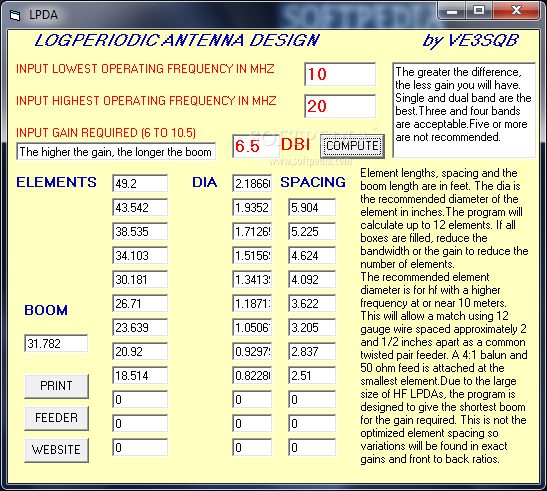Description
LPDA: Download Your Ultimate Antenna Design Calculator for Log-Periodic Dipole Arrays

In the world of wireless communication technology, proper antenna design is crucial for optimal signal transmission and reception. LPDA offers a powerful yet lightweight solution for anyone looking to download an effective antenna calculator specifically designed for log-periodic dipole arrays. This specialized software provides essential calculations for DIY antenna builders, engineers, and radio enthusiasts who need precise element specifications without complicated procedures.
Wireless Design Made Simple with LPDA Download
Communication technology has dramatically evolved, allowing data transmission through frequency modulation between antennas and receivers without physical connections. The LPDA software stands as an invaluable tool for those interested in building their own log-periodic dipole array antennas, offering precise calculations for optimal signal reception across various frequencies.
When you download LPDA, you're getting more than just a calculator - you're accessing a specialized engineering tool that transforms complex antenna design into straightforward, actionable specifications. The software's focused approach eliminates guesswork from antenna construction, ensuring your DIY communication projects meet professional standards.
Ultra-Portable Antenna Calculator

One of LPDA's standout features is its remarkable portability. The application comes in an incredibly lightweight package that doesn't require installation to function properly. After you download the LPDA calculator, simply launch it and begin working immediately. This portable antenna design tool can be stored on a USB flash drive for on-the-go usage, making it perfect for field operations or shared workstations.
The software operates without modifying your system's registry, ensuring a clean computing environment while still delivering powerful calculation capabilities for your antenna projects. This zero-footprint approach makes LPDA ideal for professionals who need to maintain multiple configurations across different machines.
Intuitive Interface for Rapid Antenna Calculations
LPDA features a compact, straightforward main window that prioritizes functionality. Users need only input a few key technical parameters to generate comprehensive specifications for their log-periodic dipole array. The application essentially functions as a specialized calculator that provides critical information about element count, thickness, and spacing for optimal signal transmission and reception.
When you download and use LPDA, you'll appreciate how the minimalist design eliminates distractions and focuses entirely on delivering accurate antenna specifications. This no-nonsense approach makes it accessible even to those with limited technical experience in antenna design.
Technical Input Parameters
- Minimum and maximum operating frequency (MHz)
- Input gain settings (range between 6-10.5)
- DBI level specifications
- Largest desired element diameter
- Wire size selection options
Comprehensive Output Specifications

- Total number of required elements
- Precise element length measurements
- Optimal element diameter specifications
- Exact element spacing requirements
- Impedance calculations (in Ohms)
- Spacing measurements (in inches)
After entering your parameters, simply click "Compute," and LPDA instantly generates all necessary specifications. The software intelligently calculates that narrower frequency gaps require fewer antenna elements, helping you create efficient designs that meet your exact communication needs without excess materials or complexity.
Advanced Feeder Calculator Functionality
LPDA includes a specialized feeder calculator that enhances your ability to properly handle antenna elements. This additional tool requires only specification of the largest diameter you wish to use, along with selection from provided wire size options. The calculator then determines appropriate diameters for all remaining elements, along with precise impedance and spacing measurements in Ohms and inches respectively.
This comprehensive approach ensures your antenna not only receives signals effectively but also maintains proper impedance matching throughout the entire array. When you download LPDA, you're getting an engineering tool that addresses both the physical construction and electrical characteristics of your antenna design.
Output and Documentation Options
While LPDA's export capabilities are somewhat limited, requiring manual copying of values to a text editor for preservation, the software does include a useful print function. This feature allows generation of documentation directly from the application, especially when used in conjunction with a virtual printer, creating permanent records of your antenna specifications for future reference or sharing.
Simplicity Meets Engineering Precision

LPDA may present a straightforward appearance, but it delivers exceptional accuracy for log-periodic dipole array design calculations. The application provides precise information regarding element requirements and size specifications to build fully functional antennas. While some users might find the interface somewhat utilitarian, this simplicity contributes to the software's accessibility and ease of use.
When you download LPDA, you're choosing a focused tool that prioritizes calculation accuracy over visual frills. The straightforward, button-based operation makes complex antenna design accessible to everyone from hobbyists to professional communication engineers. Whether you're building your first antenna or your fiftieth, LPDA provides the technical foundation for successful projects.
Download LPDA today and transform the way you approach antenna design with this specialized calculation tool that makes log-periodic dipole array construction accessible to everyone with an interest in wireless communication technology.
```
User Reviews for LPDA 8
-
for LPDA
LPDA is a handy tool for DIY antenna builders. Its simple interface and accurate calculations make it user-friendly, despite some rough edges.
-
for LPDA
LPDA is an efficient app boasting of an intuitive user interface and useful features for the modern user.
-
for LPDA
This app is fantastic! It’s lightweight, easy to use, and perfect for anyone wanting to build an antenna.
-
for LPDA
Absolutely love LPDA! It simplifies the process of calculating antenna elements with just a few inputs.
-
for LPDA
5 stars for this amazing tool! It's intuitive and provides accurate results for building antennas effortlessly.
-
for LPDA
LPDA is a game changer! No installation needed, and it works perfectly from my USB drive. Highly recommend!
-
for LPDA
I’m impressed by how straightforward this app is. Just enter the values and get instant results. Great job!

